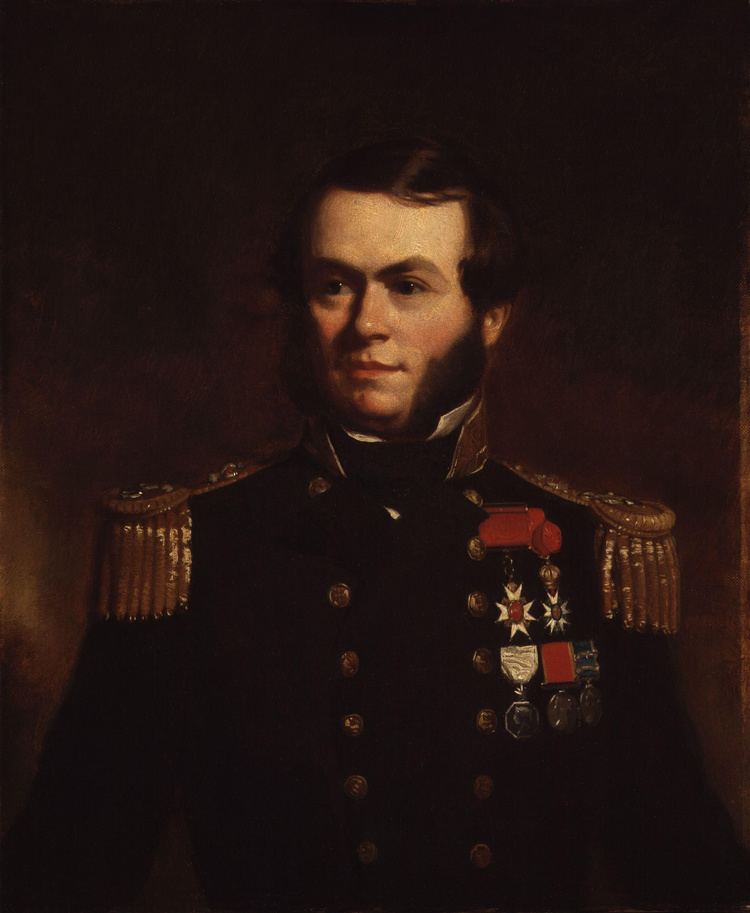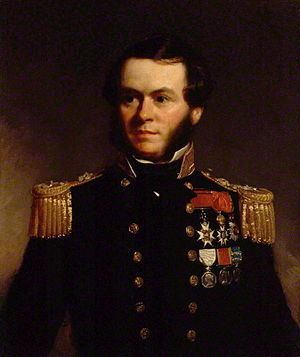Allegiance United Kingdom Name Sherard Osborn | ||
 | ||
Born 25 April 1822Madras, India ( 1822-04-25 ) Rank Lieutenant (4 May 1846)Commander (30 October 1852)Captain (18 August 1855)Rear-Admiral (29 May 1873) Commands held HMS PioneerHMS VesuviusHMS MedusaHMS FuriousHMS DonegalHMS Royal SovereignHMS Hercules Awards Companion in the Order of the Bath (1856)Legion d'honneur, 4th class (1856)Order of the Medjidie, 4th class (1858)Fellow of the Royal Society Died May 6, 1875, London, United Kingdom Books Concise Law Dictionary, The Blockade of Kedah, Stray Leaves from an A, Japanese Fragments, The career - last voyage - a | ||
Sherard Osborn (25 April 1822 – 6 May 1875), was a Royal Navy admiral and Arctic explorer.
Contents
- Early life
- Active service in Malaya and China
- The search for Franklin
- Marriage
- The Belcher expedition
- Crimean War
- Second Opium War
- HMS Donegal and the Vampire Fleet
- HMS Royal Sovereign
- Commercial Interests
- HMS Hercules
- Encouragement of the British Arctic Expedition
- Death
- References

Early life
Born in Madras, he was the son of an Indian army officer. Osborn entered the navy as a first-class volunteer in 1837, serving until 1844 in Hyacinth, Clio & Volage.
Active service in Malaya and China
In 1838, he was entrusted with the command of a gunboat at the attack on Kedah in the Malay Peninsula, and was present at the reduction of Canton in 1841 and at the capture of Woosung in 1842. From 1844 until 1848, he was gunnery mate and lieutenant in HMS Collingwood, the flagship of Sir George Seymour in the Pacific.
The search for Franklin
He took a prominent part in 1849 in advocating a new search expedition for Sir John Franklin, and in 1850 was appointed to the command of the steam-tender Pioneer in the Arctic expedition under Horatio Thomas Austin, in the course of which he performed (1851) a remarkable sledge-journey to the western extremity of Prince of Wales Island. He published an account of this voyage, entitled Stray Leaves from an Arctic Journal (1852), and was promoted to the rank of commander shortly afterwards.
Marriage
In January 1852 he married Helen, daughter of John Hinksman of Queen Anne Street, London.
The Belcher expedition
In the new expedition (1852–1854) under Sir Edward Belcher he again took part as commander of Pioneer. In 1856, he published the journals of Captain Robert McClure, giving a narrative of the discovery of the Northwest Passage.
Crimean War
Early in 1855, he was called to active service in the Crimean War as the captain of Vesuvius. After seeing considerable action in the Black Sea he was promoted to post-rank in August 1855 and was appointed to Medusa, in which he commanded the Sea of Azov squadron until the end of the war. For these services he was appointed a Companion in the Order of the Bath (CB), Légion d'honneur (4th class), and the Turkish Order of the Medjidie (4th class).
Second Opium War
As captain of Furious, he took a prominent part in the operations of the Second Opium War, and performed a piece of difficult and intricate navigation in taking his ship up the Yangtse to Hankow (1858). He returned to England in broken health in 1859, and at this time contributed a number of articles on naval and Chinese topics to Blackwood's Magazine, and wrote The Career, Last Voyage and Fate of Sir John Franklin (1860).
HMS Donegal and the "Vampire Fleet"
In 1861, he commanded Donegal in the Gulf of Mexico during the trouble there, and, in 1862, undertook the command of a squadron (the so-called "Vampire Fleet") fitted out by the Chinese government for the suppression of piracy on the coast of China; but owing to the non-fulfilment of the condition that he should receive orders from the imperial government only, he quit the appointment.
HMS Royal Sovereign
In 1864, he was appointed to the command of Royal Sovereign, the first British turret-armed battleship, in order to test the turret system of shipbuilding.
Commercial Interests
In 1865, he became agent to the Great Indian Peninsula Railway Company, and two years later was made managing director of the Telegraph Construction and Maintenance Company, a post that he held until 1874. From 1869 he was a Director of the International Mid-Channel Telegraph Co. Ltd. A cable ship was named for him and the SS Sherard Osborn was launched on 4 April 1878, for the Eastern Extension, Australasia and China Telegraph Company.
HMS Hercules
In 1871 he was appointed as captain of Hercules in the Channel Fleet. On 12 June 1873 he was appointed Rear Admiral.
Encouragement of the British Arctic Expedition
His interest in Arctic exploration had never ceased, and in 1873 he induced Commander Albert Markham to undertake a summer voyage for the purpose of testing the conditions of ice-navigation with the aid of steam. The result of this summer voyage was the British Arctic Expedition, under Sir George Nares. Osborn became a member of the expedition committee.
Death
He died in London on 6 May 1875 a few days after the expedition had sailed. His body was interred at Highgate Cemetery on 10 May 1875 with the funeral attended by many of those who had served with him in the Royal Navy.
